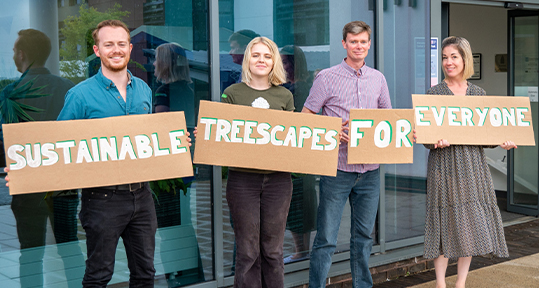An Urban Forest Master Plan outlines how to develop and manage the urban forest and defines the aspirations of stakeholders who will continue to benefit from a healthy and diverse green city.
An Urban Forest Master Plan aims to act as a roadmap, providing detailed information, recommendations and resources to effectively and proactively manage and grow a city’s tree canopy. It provides structure for the implementation of long-term strategies, which can be used to encourage all those involved to understand, respect, and enhance their urban forest.
An Urban Forest Master Plan brings together existing policies, plans, guidelines and frameworks under one umbrella. It provides a comprehensive guide to all practices involving any aspect of the urban forest, including green and blue infrastructure, both publicly and privately owned.
A Master Plan is structured around a comprehensive set of key performance indicators, informed by the current state of evidence and good practices, and developed using a collaborative process. For each of these performance indicators, an assessment of the current situation is made, ambitions are laid out, and priorities are identified. Moreover, specific actions, as well as roles and responsibilities, are defined.
There are four key questions which inform the Urban Forest Master Plan:
What do we want?
Where are we now?
How do we get there?
How are we doing?
‘What do we want?’: Developing a vision provides a starting point. Extensive stakeholder consultation is key here, as the Master Plan will encompass and affect all landowners, businesses, public bodies, as well as the local community. This consultation is of utmost importance, as stakeholder ‘buy-in’ to a shared vision will impact on the success or otherwise of its final delivery.
Coupled with the consultation process, an understanding of ‘Where are we now?’ has to be developed and articulated. Characteristics of the existing urban forest (e.g. canopy cover, the geographical location of trees, spatial inequities, species diversity, vulnerability to pests and diseases, threats posed by climate change, age classes and condition, and many other factors) are assessed in order to identify the gap between the articulated vision and the ‘now’. All of the above are likely to vary from location to location, with different levels of understanding and knowledge apparent and different characteristics emerging. It is likely to demonstrate that no two communities are the same and that there is no one package which will fit all. Each community is likely to evolve its own vision and the purpose of extensive consultation and knowledge gathering is to express this.
The next stage is to construct the Plan and create a road map to achieving its vision: ‘How do we get there?’. It is at this point that the Urban Forest Master Plan can be truly differentiated from the many aspirational tree strategy documents available today. While these are often well intended and provide guidance, they rarely provide the detailed road map necessary if long-term strategic urban forest management and the benefits it delivers are to be achieved.
From the assessment of ‘Where are we now?’, a detailed and prioritised list of actions is identified. Again, these will vary from locality to locality, with different necessary actions identified. These actions are prioritised and may include the gathering of more information to answer more fully the question of where we currently are. From this point, each action is assessed and the ‘Where are we now?’ element included to provide the starting point for further development. What emerges is a defined set of actions, each assessed as to their current position. This methodology is often defined as the use of ‘criteria and indicators’.
The delivery of each of the actions, having been prioritised, is allocated to specific individual people and organisations (or both), ideally with budgetary information and resource allocation. Progress is then recorded. Each of the actions is focused on the achievement of the original vision.
The Urban Forest Master Plan is reviewed on a regular basis and may be modified as various actions are achieved and performance indicators met. As such, its impacts and successes must be monitored and reviewed. Dividing a Master Plan into smaller targets makes this task more manageable. Outlining a number of key indicators for the overall success and health of the urban forest and monitoring performance will help achieve the goals, and ultimately, the wider vision which is established by the Plan.


